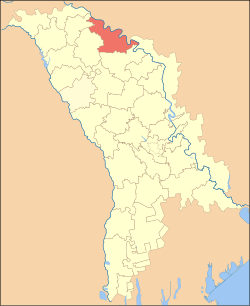Soroca District
| Soroca | |||
|---|---|---|---|
| District (Raion) | |||
|
|||
 |
|||
| Country |
|
||
| Administrative center (Oraş-reşedinţă) |
Soroca |
||
| Government | |||
| • Raion President | Mircea Martîniuc | ||
| Area | |||
| • Total | 1,043 km2 (403 sq mi) | ||
| Elevation | 347 m (1,138 ft) | ||
| Population (2012) | |||
| • Total | 100,100 | ||
| • Density | 96.0/km2 (249/sq mi) | ||
| Time zone | EET (UTC+2) | ||
| • Summer (DST) | EEST (UTC+3) | ||
| Postal Code | 230 | ||
| Area code(s) | +373 30 | ||
| Car plates | SR | ||
| Website | www.soroca.org.md | ||
Soroca is a district in north-east Moldova. Its administrative center is the town of Soroca. At 1 January 2011, the population of the region was 100400.
Archeological evidence of prehistoric occupation dating to 35000 to 50000 years ago has been found in the Soroco region near the village of Rudi. In about 400 to 300 BCE, ancient defensive walls were constructed. From the 9th century to the 12th century CE, two cities developed. They were called "Farfuria Turceasca" and "Germanariul". In the 12th and 13th centuries, a genoese fortress appeared at Alchiona. In the period 1439-1457, villages are mentioned: Visoca, Vasilcău, Rudi and Pirlita.
In the second half of the 16th century, Stephan the Great built a wooden fortress on the former Alchiona mount. The fortress was transformed into its present form between 1543-1546 during the reign of Peter IV Rareş. The creation of the town allowed for trade along the Nistru while providing protection from foreign invasion. For many years Soroca was a centre for arts and agricultural markets for the Principality of Moldova. At various points in time, Soroca was affected by wars with Tartars, Cossacks, Poles and Russians. Between 1684-1699, under control of the Poles, changes in Soroca were made. A deep moat was dug; a well was dug in the courtyard. 14 stone casemates inside . Gradually over time, with more stable rule, the town and its region lost military importance.
In 1812, Soroca was occupied by Russia. The population became more varied as Russians, Ukrainians and Jews moved to the region. From 1849 to 1917 Soroca was governed as part of the Basarabia region of the Russian Empire. In 1918, at the conclusion of World War I, Bessarabia was made part of Romania. Until 1944, Soroca remained the administrative centre for this Romanian region. In 1944, as World War II reached its end, Soroca became part of the MSSR. Moldova became an independent state in 1991. Soroca has since remained an administrative region of Moldova.
...
Wikipedia


